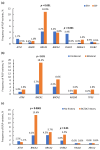High- and Moderate-Risk Variants Among Breast Cancer Patients and Healthy Donors Enrolled in Multigene Panel Testing in a Population of Central Russia
- PMID: 39684352
- PMCID: PMC11641773
- DOI: 10.3390/ijms252312640
High- and Moderate-Risk Variants Among Breast Cancer Patients and Healthy Donors Enrolled in Multigene Panel Testing in a Population of Central Russia
Abstract
Assessments of breast cancer (BC) risk in carriers of pathogenic variants identified by gene panel testing in different populations are highly in demand worldwide. We performed target sequencing of 78 genes involved in DNA repair in 860 females with BC and 520 age- and family history-matched controls from Central Russia. Among BC patients, 562/860 (65.3%) were aged 50 years or less at the time of diagnosis. In total, 190/860 (22%) BC patients were carriers of 198 pathogenic/likely pathogenic (P/LP) variants in 30 genes, while among controls, 32/520 (6.2%) carriers of P/LP variants in 17 genes were identified. The odds ratio [95% confidence interval] was 16.3 [4.0-66.7] for BRCA1; 12.0 [2.9-45.9] for BRCA2; and 7.3 [0.9-56.7] for ATM (p < 0.05). Previously undescribed BRCA1/2, ATM, and PALB2 variants, as well as novel recurrent mutations, were identified. The contribution to BC susceptibility of truncating variants in the genes BARD1, RAD50, RAD51C, NBEAL1 (p. E1155*), and XRCC2 (p. P32fs) was evaluated. The BLM, NBN, and MUTYH genes did not demonstrate associations with BC risk. Finding deleterious mutations in BC patients is important for diagnosis and management; in controls, it opens up the possibility of prevention and early diagnostics.
Keywords: ATM; BRCA1/2; breast cancer risk; healthy controls; multigene panel testing; pathogenic variant; patients.
Conflict of interest statement
The authors declare no conflicts of interest.
Figures






Similar articles
-
Familial breast cancer and DNA repair genes: Insights into known and novel susceptibility genes from the GENESIS study, and implications for multigene panel testing.Int J Cancer. 2019 Apr 15;144(8):1962-1974. doi: 10.1002/ijc.31921. Epub 2018 Nov 13. Int J Cancer. 2019. PMID: 30303537 Free PMC article.
-
New germline mutations in BRCA1, ATM, MUTYH, and RAD51D genes in Tuvans early-onset breast cancer patients.Exp Oncol. 2021 Mar;43(1):52-55. doi: 10.32471/exp-oncology.2312-8852.vol-43-no-1.15587. Exp Oncol. 2021. PMID: 33785725
-
New germline BRCA2 gene variant in the Tuvinian Mongol breast cancer patients.Mol Biol Rep. 2019 Oct;46(5):5537-5541. doi: 10.1007/s11033-019-04928-y. Epub 2019 Jul 4. Mol Biol Rep. 2019. PMID: 31273614
-
[The clinical importance of a genetic analysis of moderate-risk cancer susceptibility genes in breast and other cancer patients from the Czech Republic].Klin Onkol. 2012;25 Suppl:S59-66. Klin Onkol. 2012. PMID: 22920209 Review. Czech.
-
Moderate penetrance genes complicate genetic testing for breast cancer diagnosis: ATM, CHEK2, BARD1 and RAD51D.Breast. 2022 Oct;65:32-40. doi: 10.1016/j.breast.2022.06.003. Epub 2022 Jun 18. Breast. 2022. PMID: 35772246 Free PMC article. Review.
References
-
- Bergstrom C., Pence C., Berg J., Partain N., Sadeghi N., Mauer C., Pirzadeh-Miller S., Gao A., Li H., Unni N., et al. Clinicopathological Features and Outcomes in Individuals with Breast Cancer and ATM, CHEK2, or PALB2 Mutations. Ann. Surg. Oncol. 2021;28:3383–3393. doi: 10.1245/s10434-020-09158-2. - DOI - PubMed
-
- Yadav S., Boddicker N.J., Na J., Polley E.C., Hu C., Hart S.N., Gnanaolivu R.D., Larson N., Holtegaard S., Huang H., et al. Contralateral Breast Cancer Risk Among Carriers of Germline Pathogenic Variants in ATM, BRCA1, BRCA2, CHEK2, and PALB2. J. Clin. Oncol. 2023;41:1703–1713. doi: 10.1200/JCO.22.01239. - DOI - PMC - PubMed
MeSH terms
Grants and funding
LinkOut - more resources
Full Text Sources
Medical
Research Materials
Miscellaneous

